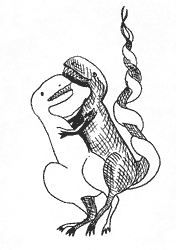STRANGE BUT TRUE- Dinos did it: T-rex's earth-shaking sex

DRAWING BY DEBORAH DERR McCLINTOCK
Q. Thinking back many eons, wouldn't a pair of passionate T. rexes heaped upon one another have broken some bones? How on Earth did dinos do it? –M. Crichton
A. Paleontologists have suggested they mated a little like lizards, with tails and legs intertwined, placing some mighty forces on the female's hind legs and the male's down rear leg. Too much weight to bear? Not at all, answers zoologist R. McNeill Alexander in Dynamics of Dinosaurs & Other Extinct Giants. Picture yourself walking: At times all your weight is on a single leg, doubling the bone stress of just standing. Running, you put triple the stress on each leg without causing problems.
Even if the down dino had to bear all the weight of the duo, peak bone forces would only have been about double the standing forces. Ergo: "If dinos could walk, they could also have sex– and obviously did both successfully."
Q. How in just a few short weeks might you convince someone you're a stock-forecasting savant, even when you're not? Don't really try this! –M. Milken
A. Take a list of 1024 investors and send them a letter on Monday, outline Edward Burger and Michael Starbird in The Heart of Mathematics. To 512 of them you write, "IBM stock will go up next week"; to the other 512 you say, "IBM stock will go down next week."
The following week, you send 512 letters to the group for whom you predicted correctly, and to 256 you write, "IBM stock will go up next week," and so on. At the end of that week, 256 people are starting to pay attention to your forecasting savvy. Then it's on to 128 letters, 64, 32, 16, 8, 4, 2.
"After nine weeks, two people will have seen you predict the future nine times in a row," the authors say. Now you ask them to send a large check requesting your next week's prediction, followed by an "up" letter to one, "down" to the other. Later, to assuage your conscience, you return the check to the person you misled.
Presumably, this sort of scam is illegal, but it happens inadvertently in another way: There are thousands of people who predict stock market activity, many in good faith, and some will be correct sometimes. "The moral of this story is beware of investment counsel that says, 'This expert correctly predicted the big crash of 1987,'" Burger and Starbird conclude.
Q. How do the words "blizzard" and "blizard" differ, and what's their origin anyway? –W. Skeat
A. As a massive wind-driven snow event, "blizzard" is of debatable origin, but initially it meant "a stunning blow" such as a boxer's knockout punch, says Randy Cerveny in Freaks of the Storm. U.S. frontiersman Davy Crockett himself once referred to "taking a blizzard" (in this case a rifle shot) at a deer. Then in 1870 an Iowa newspaper editor used "blizard" to describe a snowstorm that had "K.O.'ed" his city. Within a few years, papers in the U.S. and Canada were using the weather term.
The Great Blizzard of 1888, one of the worst in American history, unloosed 70 mph winds and 20-foot plus drifts and killed 400. Out of that blizzard came the story of businessman C. H. McDonald, who while mired in a snowdrift, collided with a hard object and got a nasty gash on the head. It turned out to be the hoof of a frozen horse, prompting him to later tell friends, "I'm the only man ever to be kicked in the head by a dead horse."
Q. Late one night, the Chief Medical Examiner for New York City got a call from the distraught family of a man who had died at a subway station, apparently by throwing himself off the waiting platform onto the rails. In that system, the third rail is "hot," possibly electrocuting him. At the autopsy, the examiner found no evidence of stroke or heart attack but did uncover a few curious burns. The moral of the story as it emerged from the investigation was a) an apparent suicide isn't always what it seems b) don't get drunk if you can't hold your alcohol c) even a minor act of indiscretion can kill you d) unsuspected dangers may lurk at a subway terminal e) curious burns uncovered may spark a curious conclusion f) all of the above. –R. Giuliani
A. All fit what the doc was able to piece together: that the deceased would often become belligerent when drunk, prompting him to urinate in public, and that if he did this from the subway platform, the electricity of the hot rail could easily have followed the urine stream up to the victim's thumb, first finger, and private part of his body– those curious burn sites, says Jearl Walker in The Flying Circus of Physics. Case closed, if you can believe it!
Send Strange questions to brothers Bill and Rich a [email protected].
#